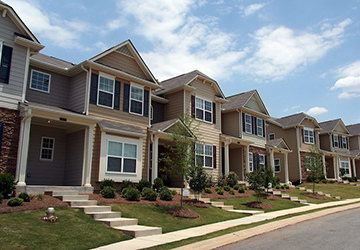Have you considered buying a zero-lot home? It sounds like a complicated and daunting investment. After all, what the hell does "zero lot line" mean? This type of home is prevalent today and offers many advantages to the homeowner.
In this blog post, we outline the definition and benefits of buying a zero-lot line home, giving readers peace of mind knowing exactly what they are getting into before making such a significant investment.

Define zero lot line houses
A zero-lot line home is a single family home attached to one or more neighbor's homes with no current lot line between them. Although your house will be built on its land, it will be connected to other places in your development along shared walls.
Essentially, zero-lot-line homes are simple accessory housing units—similar to townhouses or condominiums—where each owner is fully responsible for their property but shares a common wall with neighbors.
What is unique about these types of homes is that there is often no yard (or only a tiny yard) associated with the property. Most come with an HOA agreement that enforces specific rules regarding the appearance and maintenance of the development.
The benefits of buying a zero lot line home
As with any home purchase, there are pros and cons to buying a zero-lot line home. Here are some advantages:
Cost - Generally, these homes cost less than detached single-family homes due to their smaller square footage and lack of outdoor space.
Maintenance - HOA agreements associated with homes with zero lot lines generally ensure that all residents maintain their property, which means you won't be liable for messes or damage to your neighbors.
Taxes - Depending on your area, you may be eligible for lower taxes if you buy a zero-lot line home.
Location - These homes are increasingly popular in densely populated areas, giving buyers more options for housing in desired locations.
By understanding the advantages of buying a zero-lot line home, you can decide if this type of home is right for you. Before making any decisions, be sure to research your area's zoning laws and HOA agreements to understand the types of restrictions that may apply.
Disadvantages of buying a line zero home
Despite the advantages of buying a zero-lot line home, there are also some disadvantages to consider before making such a significant investment. Here are some potential adverse effects associated with this type of person:

Privacy - Since your home is attached to your neighbor's walls along the shared lot line, you have less privacy than if you had a detached single-family home.
Noise - Because sound can travel through walls, it can be challenging to avoid loud neighbors.
Restrictions - The HOA agreement associated with your community may include restrictions limiting how much you can personalize and customize your property.
Resale value - Typically, these homes have a lower resale value than detached properties.
As with any home purchase, it's essential to research and understands the potential downsides of buying a zero-lot line home before making such a significant investment. Check your area's zoning laws and HOA agreements to see what restrictions apply.
Talk to real estate professionals and homeowners who live in similar developments to get their perspectives on the pros and cons of this type of housing.
Tips for decorating and furnishing a zero lot line home
Decorating and furnishing a zero-lot home can be fun and exciting, but it's important to remember that your options may be fewer than those of other types of homes due to space constraints. Here are some tips for making the most of your living space:
Use vertical storage - this is especially helpful in a kitchen with a little counter or cabinet space. Use ledges, shelves, and hanging baskets to maximize your storage options while keeping clutter out of the floor.
Invest in multifunctional furniture - look for pieces that double as seating and storage, such as an ottoman with built-in drawers or a coffee table with a cubby underneath. Invest in furniture with multiple uses
It will help you maximize your small space
Use natural light - keep window decoration simple and use mirrors to reflect more natural light. This helps make the room appear larger and more airy while reducing energy costs.
Use bright colors - Using bright and bold colors can make a small room appear larger. Choose accent walls or furniture to add color, but keep the rest neutral for balance.
Remember these tips, and you can get the most out of your zero-lot line home.
Things to consider before moving into a zero-lot line home
When considering a zero-lot line home, there are several factors you should consider before moving. Here are a few things to consider when deciding if this type of man is right for you:
What is your neighborhood like? - While living in a house with zero lot lines means you will have less privacy, it is still important to know what kind of people you will live next to. Research your neighbors ahead of time and learn about their lifestyles to better understand the types of restrictions or noise levels you may need to contend with.
What are the HOA requirements? - Read your HOA agreement carefully and understand all the rules and regulations of living in a zero-lot line home. This will help you understand what types of restrictions may be imposed on how your property can be maintained or modified.
What is your budget? - Typically, these homes may have a lower resale value than a detached home. Make sure you understand the cost of a zero-lot line home and how it fits into your budget.
By considering all of these factors, you can better decide whether this type of housing is right for you.
FAQ
How is a zero-lot line home different from a traditional home?
Zero lot line homes have no front or backyard; the home's walls are built to the edge of the lot boundary. This means less space between adjacent houses, increasing privacy, and more efficient land use.
How can I find lot zero homes in my area?
Research online if you're looking for zero-lot line homes in your area. Look up local real estate listings to see if any developments or communities offer this type of housing. You can also contact local developers and builders to get their opinions on the pros and cons of this type of home.
You can ask friends and family if they know of any developments or communities that offer this type of housing. Finally, remember to check your local newspapers for any potential listings.
What is Calgary's, Lot Zero?
A lot zero in Calgary is a home whose walls are built on the edge of the lot boundary. This means less space between adjacent houses, increasing privacy, and more efficient land use.
Zero-lot homes can offer many advantages, such as reduced landscaping costs, construction costs, and a reduced carbon footprint. The West Springs community is an example of Calgary offering zero-lot housing.
In conclusion
Due to its many advantages, zero-lot line home construction is on the rise. While it's not for everyone, those who can buy a zero-lot line home should take the time to understand what they're getting into. Through due diligence and familiarity with local laws and regulations, potential homebuyers can decide what is best for them and their family.





